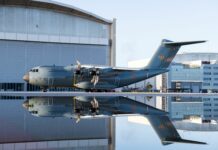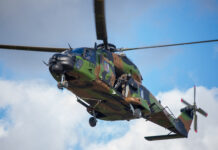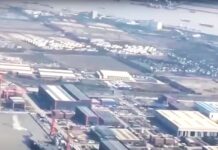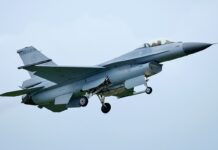In the second week of April 2022, six of the latest X’ian Aircraft Industrial Corporation Y-20A transport aircraft of the People’s Liberation Army Air Force (PLAAF) appeared at Nikola Tesla International Airport in Belgrade, much to the surprise of many Western observers.
The appearance of the six Y-20A transport aircraft, apparently delivering an unspecified cargo, was part of the ongoing cooperation between Belgrade and Beijing according to Chinese Foreign Ministry spokesperson, Zhao Lijian. In the meantime, Serbian President, Aleksandar Vučić, announced that the Chinese were delivering FK-3 surface-to-air missiles (SAM), the export variant of the HQ-22 SAM system, as part of Serbia’s re-armament programme.
The arrival of the Chinese transport aircraft in Europe attracted the attention of aviation enthusiasts watching the Flightradar24 App, and shared through the ADSB global exchange website, as they transited through Baku International Airport in Azerbaijan, before crossing Turkish airspace and landing in Belgrade, though they were unlikely to be aware of the significance of their appearance.
At the AIRPOWER22 air show, held on 2-3 September 2022 at Zeltweg Air Base in the Austrian state of Styria, one PLAAF Y-20A appeared as the star attraction, along with the last public appearance of the Austrian Armed Forces (Bundesheer) Aerospatiale Alouette III legacy helicopter.
The Y-20 has a deceptive appearance. At a distance, it resembles the United States Air Force (USAF) Boeing C-17A Globemaster III, but on closer inspection, it is in fact not only different, but also smaller. The Y-20A has been under development for over a decade, and there are elements in its design that have come about with Russian help, such as the Antonov Aircraft Design Bureau with the Y-20A’s nose resembling that of the Antonov An-178.
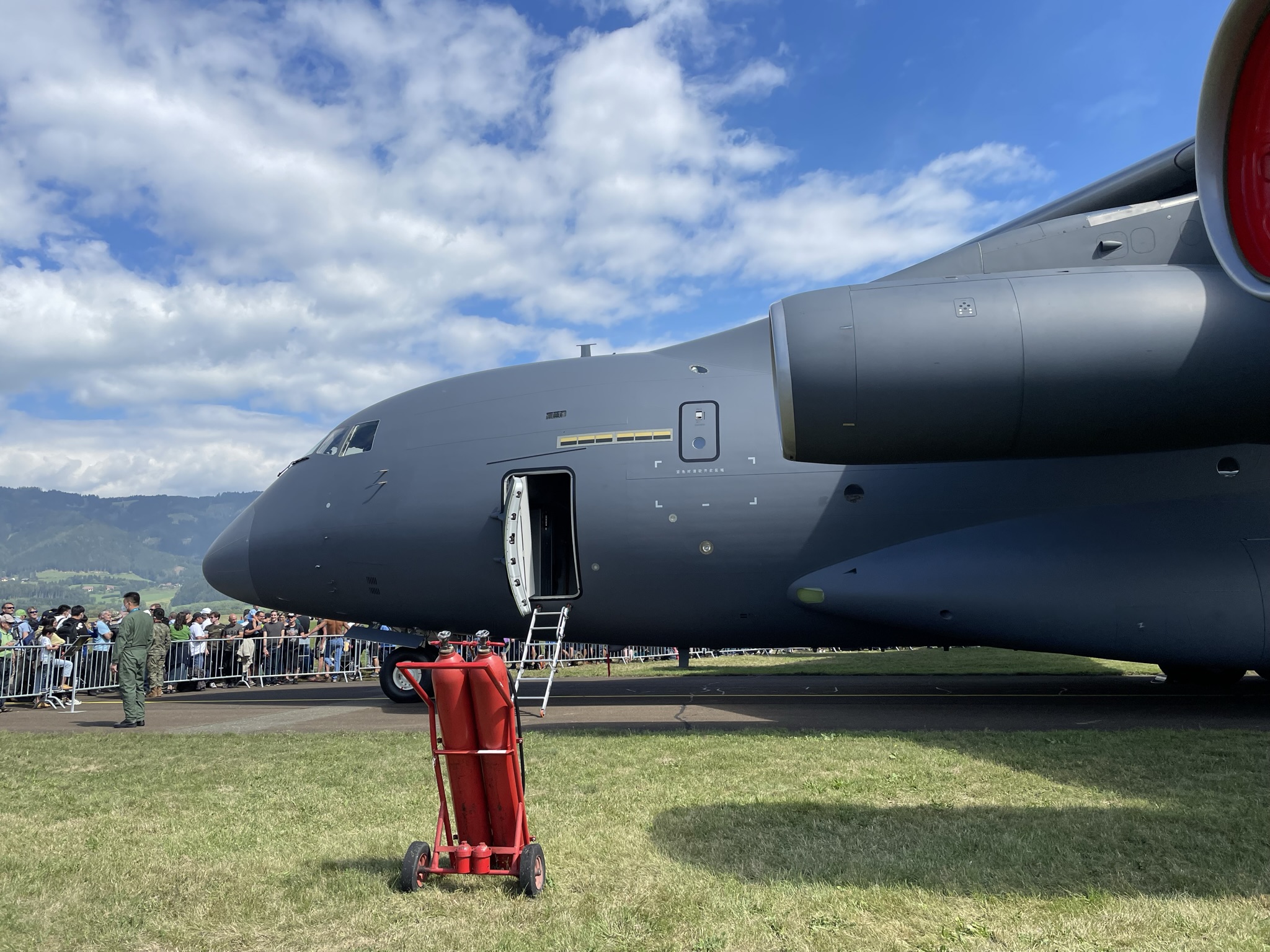
Credit: Ian V Frain
The Millennium Airlifter
The development of the Y-20 was accelerated following the 2008 earthquake in China’s Sichuan Province, a tragic natural disaster that demonstrated the urgent need for an airlifter in that class.
The PLAAF has been using the smaller Shaanxi Y-9 ‘Mist’ aircraft powered by four turboprop engines and the legacy Xi’an Y-7G. The latter was based on the design of the Russian Antonov An-24 transport aircraft. The Chinese derivative of the An-24 first flew as far back as 1970, and since then there have been no less than 14 variants including one Airborne Early Warning (AEW) variant, the Xian JZY-01/Y-7 AWACS. More recently, this particular variant has been used as a testbed for the new carrier-based Xi’an KJ-600 for China’s new aircraft carriers.
The Y-20 combines the latest manufacturing technology and composite materials in the aircraft construction, which leads to a reduction both in its overall weight and in fuel consumption. The Y-20 has numerous unique features, such as the airframe, which includes high-lifting devices along the wings’ leading and trailing edges, which is aerodynamically advantageous. The aircraft has a supercritical wing design which provides increased lift, reduced drag, and the airflow over the wing can almost be supersonic. The Y-20 was designed to operate closer to the edge of battle with short (unprepared) runways and has an undercarriage with six pairs of main landing wheels.
The first Y-20 prototypes were powered by Russian 12-tonne thrust Soloviev D-30-KP-2 engines, which thereafter became the standard for those coming off the production line. However, the PLAAF’s longer-term plans include the latest versions, the Y-20B, due to be powered by an indigenous power plant, following a considerable amount of research and development. The result is the Shenyang WS-20 high bypass turbofan aircraft. A Y-20B prototype fitted with the WS-20 flew for the first time at the end of 2020.
As with the latest western transport aircraft of the Airbus A400M Atlas or Boeing C-17A Globemaster III class, the Y-20 has a modern digitised avionics suite and is also equipped with Fly-By-Wire (FBW) technology. The Y-20 boasts a four-crew glass cockpit with two Heads Up Display (HUD) units, and five large Multi-Function Displays (MFD) to ease pilot workload. The aircraft has an Enhanced Vision System (EVS) installed below the forward windshield to assist in taking off and landing under adverse weather conditions.
A Candid Move
Around two decades ago, the Chinese military ordered about a dozen Russian United Aircraft Corporation (formerly known as Ilyushin) Il-76MD/TD aircraft (NATO reporting name: Candid), and during the course of 2005, they ordered an additional 34 airframes. However, the order and subsequent deliveries were hampered by the collapse of Ilyushin itself. Finally, in 2012, all Il-76 deliveries were completed, including an additional three second-hand Il-76MD/TD aircraft ordered the previous year. The Il-76 has been in the Russian Air Force’s service since the late 1960s, forming the backbone of their strategic airlift before the introduction of the heavier Antonov An-124 (NATO reporting name: Condor). It is understood that the Il-76 will be replaced by the Y-20 in the future.
Fuelling the Flight
The PLAAF has amassed a large amount of fourth and fifth generation combat aircraft over the last two decades. It has done so through purchasing, as well as manufacturing under licence, as with the case of the Russian Sukhoi Su-27 becoming the J-11 in PLAAF service and J-15 in the inventory of the People’s Liberation Army Navy (PLAN) aviation. There are also numerous variants of the indigenously produced J-10 fast jet, the JF-17 single-engine, single-seat fighter, and the latest fifth generation J-20 Mighty Dragon and JF-35 Blue Shark. Expanding into the Indo-Pacific region with this larger fleet has necessitated the creation of a greater Air-to-Air Refuelling (AAR) capability. For three decades, the PLAAF used a derivative of the legacy Russian Tupolev Tu-16 strategic bomber (NATO reporting name: Badger), known as H-6U, built by X’ian. There are versions of the H-6U used for the AAR role, after being equipped with a pair of underwing hose-and-drogue RDC1 refuelling pods.

Credit: Japanese MoD
The majority of the H-6U tanker fleet is based in the east and south-east of the country, as Taiwan is currently the focus of Chinese strategic policy. The small island, formerly known as Formosa, has experienced aggressive moves from China for several decades, from naval manoeuvres to near incursions by PLAAF aircraft. The design may be six decades and over, but the PLAAF fleet underwent a number of improvements with regard to avionics, such as the new navigational equipment, including an Inertial Navigation System (INS) and Global Positioning System (GPS), which were installed along with an improved flight control system. One drawback of the H-6U is its inability to conduct AAR operations at night following a number of trials, which resulted in the decision that this aircraft would not conduct routine night operations.
The PLAAF also operates the tanker version of the Ilyushin Il-76, known as the Il-78 (NATO codename Midas). The Il-78’s configuration includes two large fuselage tanks that carry 80,000 lb of auxiliary fuel. Both of these tanks are mounted on fixed pallets which are carried on the main freight deck. The original Il-78 tankers initially served in a dual role, tasked with both transport and AAR, but more recently, the PLAAF Il-78 aircraft have been employed as dedicated tankers, with a single large fuselage tank fitted for auxiliary fuel.
With the modernisation of the PLAAF fast jet fleet, plans are afoot to replace the H-6U with a tanker version of the Xi’an Y-20, known as the YY-20. The YY-20 is equipped with the newer RDC3 refuelling pods, with one each located on the wing stations and one on the centreline of the aircraft. As with other AAR tankers in the global marketplace, such as the twin-engine Airbus A330 MRTT (Multi Role Tanker Transport) and Boeing’s KC-46A Pegasus, the YY-20 is equipped with infrared (IR) and television cameras mounted on the fuselage to assist the aircrew (especially the air refuelling airman) when conducting refuelling operations safely, day or night. As with the Y-20A/B transport, the YY-20 is in the process of replacing the Il-78 in the AAR role for the PLAAF.
Turbo Transports
The PLAAF may have the latest heavy jet powered strategic transports and AAR platforms, but they also hold a substantial number of turboprop airframes. In 2005, at the 11th Beijing Air Show, the new four-engine turboprop Shaanxi Aircraft Company Y-9 was unveiled, with the first prototype then flown in 2010 and deliveries commencing in 2012.
Powered by four WJ-6C engines, the Y-9 was intended to replace the older legacy Y-8 (Antonov An-12). The engines themselves provide 5,100 shaft horsepower (SHP) and are fitted with composite blades for increased performance at high altitude. Interestingly, the tail has additional vertical stabilisers to assist the aircraft with maintaining stability at very low speeds. As with other modern airlifters in its class, the aircraft has an all-glass cockpit consisting of Multi-Function Displays (MFD), and Electronic Flight Information Systems (EFIS) to ease pilot workload. It is also equipped with an optronic Forward Looking Infrared (FLIR) sensor to aid with low-level flights or in adverse conditions, as well as in possible special operations. In terms of capacity, the Y-9 can carry just under 100 paratroopers or between 13—15 tonnes of cargo. The PLAAF is not the only operator of the Y-9, as two examples were briefly in China’s Army Aviation Corps before being returned to the PLAAF, while the People’s Liberation Army Navy (PLAN) acquired the Y-9 about three years ago in 2020.
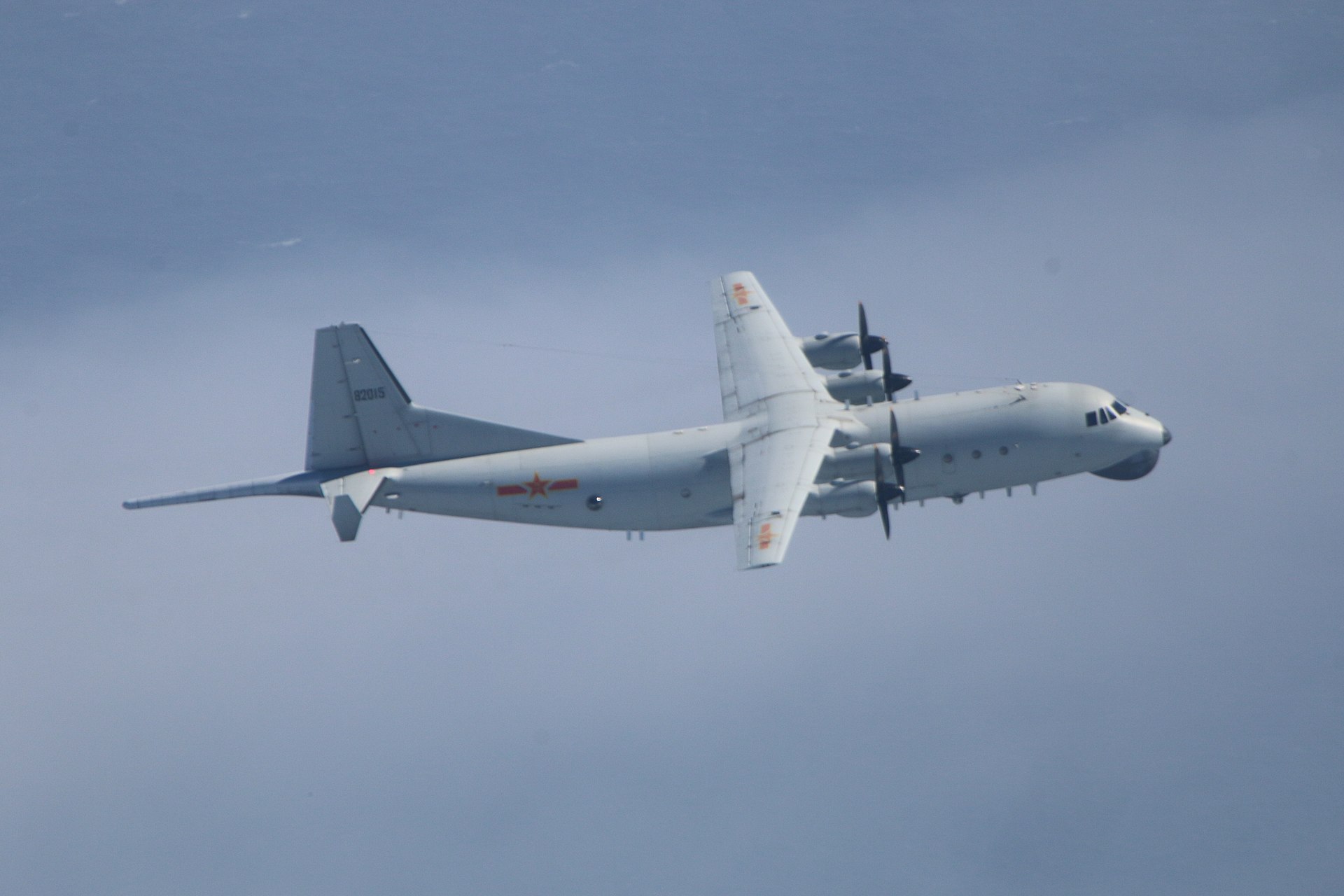
Credit: Taiwanese MoND
Another modern PLAAF turboprop is the Short Take Off and Landing (STOL) twin-engine Harbin Y-12D, which entered service in 2015 in the light transport and paratrooping role. The Y-12D evolved from a 40-year old design, which began life as the Y-11 in the early 1980s. The early versions of the Y-12 were unique in that they were powered by western engines, in this case the Canadian Pratt & Whitney, Canada (PW & C) PT6A-11, and now have the newer four-blade locally-produced WJ-9 engines. With regard to the use of the PT6A-11, the Y-12 civilian version was actually certified by the United States Federal Aviation Administration (FAA) in 1995.
The Y-12D is more of an army aviation asset as it serves in the Peoples Liberation Army Airborne Corps, which replaced the Russian Antonov An-2 biplane (NATO reporting name: Colt), Y-5 in the paratrooper drop role.
Distinguished Flying
As with many air arms around the globe, the PLAAF has a small fleet of Distinguished Visitor (DV)/Very Important Person (VIP) aircraft to transport the president/prime minister, and other dignitaries around the country, and also globally. These aircraft have also served in a secondary role as an airborne command post, such as one two-engine Boeing 737-3Q8 in their fleet. This particular airframe is based on the 737CL (Classic), and was converted from an airline configuration (operated previously by China United Airline) into an airborne command post by Xi’an.
The PLAAF also operates a small number of the Boeing 737NG (New Generation) in the DV/VIP role. These were initially painted with civilian markings and registrations, but now have PLAAF symbology and military markings. Additionally, the PLAAF operates the more modern Airbus Corporate Jets (ACJ) A319, with three currently in service.
The Dragon’s Global Presence
In 2022, from the escalating tensions in the South China Sea and Taiwan Strait, to the surprise presence of the Y-20 in the Balkans and the international air show in Austria, the PLAAF has demonstrated a global reach capability beyond the Indo-Pacific region. Over the past decade, PLAN units have deployed to the Horn of Africa as part of the international effort to combat piracy against international shipping. A small aviation element of the Chinese military is seen with the shipborne Harbin Z-9 Dauphin, which is a licence-built version of the Aerospatiale (then Eurocopter, and now Airbus Helicopters) AS365N/AS565F Panther multi-role helicopter. The PLAN has established a naval base in Djibouti to support these activities in the region over the last six years. There is also a proposal to establish another naval base in Equatorial Guinea, covering the Atlantic.

PLAAF air transport capabilities are also expanding with the introduction of the Y-20 and YY-20. In the West, the new airframes match the capabilities of the American Boeing C-17A and European Airbus A400M, as well as the Airbus A339 MRTT (Multi Role Tanker Transport). However, it does not stop there, as it is rumoured that the PLAAF (as of 2022), is developing a heavier strategic transport aircraft, thought to be around the Lockheed C-5M Super Galaxy and Antonov An-124 four-engine class. With 2023 being the Chinese Year of the Rabbit, it seems the PLAAF and China’s air industry are in a good place to continue upwards and outwards.
Ian Frain



